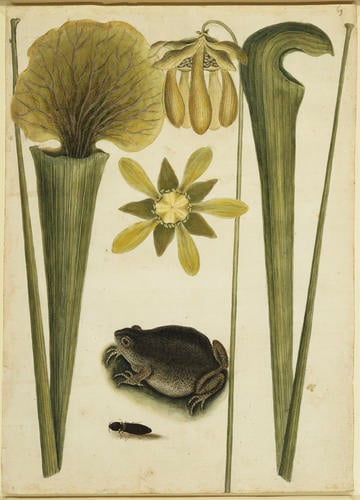-
1 of 253523 objects
The Land Frog, Fire-Fly, and Sarracena, foliis longioribus et angustioribus c.1722-26
Watercolour and gouache heightened with gum arabic, over graphite | 37.1 x 26.8 cm (sheet of paper) | RCIN 926020

Mark Catesby (1682-1749)
The Land Frog, Fire-Fly, and Sarracena, foliis longioribus et angustioribus c.1722-26
-
A watercolour of a southern toad (Anaxyrus terrestris (Bonnaterre)), a fire beetle (Pyrophorus noctilucus (Linnaeus)), and several separate studies of a hooded pitcher plant (right, Sarracenia minor Walter) and a yellow pitcher plant (left, Sarracenia flava L.). There are separate studies of the insect trap, leaves and flowers.
The English naturalist Mark Catesby made two extended visits to the British colonies in North America and the Caribbean, in 1712-19 and 1722-6. From the material assembled on these expeditions Catesby published the first fully illustrated natural history of North America, his Natural History of Carolina, Florida and the Bahama Islands, in two volumes issued in parts between 1729 and 1747, with parallel commentaries in English and French. The first volume was dedicated to Queen Caroline, consort of George II, and the second to Princess Augusta, wife of Frederick, Prince of Wales. In 1768 George III, the grandson of Caroline and son of Augusta, purchased a three-volume copy of the Natural History including 263 original watercolours, among which were nearly all the preparatory studies for the 220 etchings in the Natural History.
This is the model for plate 69 of the second volume of the Natural History. The pitcher plant is of the genus Sarracenia and named by Catesby Sarracena, foliis longioribus & augustioribus. Its morphology, with a smoothly domed ‘lid’, is that of the hooded pitcher plant (Sarracenia minor), though Catesby has not depicted the characteristic translucent ‘windows’ (aureoles) on the back of the pitcher. The hooded pitcher plant however grows to a height of only 18’ (45 cm), and in his notes to the plate Catesby states that ‘The Leaves ... arising from a knotty fiberous Root, [grow] to the Height of about three Feet’, suggesting that he conflated that plant with the more common yellow pitcher plant (Sarracenia flava), widely distributed from southern Alabama through Florida and northwards to Virginia, and cultivated in Europe by 1753. The pitchers of that species do grow to a height of 3 feet (90 cm), but its ‘lid’ is erect, relatively narrow, and culminates in a pronounced ridge. The veining of the inside of the lid, described by Catesby as ‘of a greenish Yellow, veined with Purple’, is very variable among individual specimens across the Sarracenia.
Catesby was unaware of the insectivorous nature of the pitcher plants - indeed he regarded the leaves as a safe haven for insects, suggesting that ‘The Hollow of these Leaves ... always retain some Water, and seem to serve as an Asylum or secure Retreat for numerous Insects from Frogs and other Animals, which feed on them’, and proposing that the purpose of the lid was to shelter the trumpet from rain, preventing it from overfilling and collapsing from the weight of the water within.
Below is a toad, probably the southern toad, which Catesby however asserted to be a ‘Land Frog’: ‘Their Bodies are large, resembling more a Toad than a Frog, yet they do not crawl as Toads do, but leap.’ The click-beetle, unaccountably omitted in the engraved plate, is Pyrophorus noctilucus, the largest and brightest of the ‘fire-flies’ (the common name for all bioluminescent insects). Catesby’s commentary gives the following rather grim anecdote:
’As I was sitting in a sultry Evening, with some Company without Doors, one of us let fall from a Pipe of Tobacco some light burning Ashes, which was immediately catched up and swallowed by a Frog of this Kind. This put us on tempting him with a red hot Wood Coal, not less than the end of ones Finger, which he also swallowed greedily; thus afterwards I always found one or other of them easily deceived in this Manner, as I imagine, by taking it to be a Cicindela, or Fire-Fly, which in hot Nights are very numerous in Virginia and Carolina, where also these Frogs abound.’
Text adapted from Holbein to Hockney: Drawings from the Royal CollectionProvenance
Thomas Cadell; from whom bought by George III, 1768
-
Creator(s)
Acquirer(s)
-
Medium and techniques
Watercolour and gouache heightened with gum arabic, over graphite
Measurements
37.1 x 26.8 cm (sheet of paper)
Other number(s)
RL 26020Alternative title(s)
The Land Frog and Sarracena, foliis longiovibus and anguftioribus; Bucanephyllon elatius Virginianum